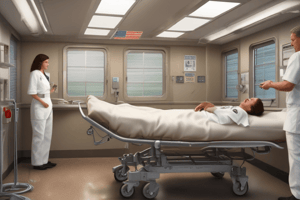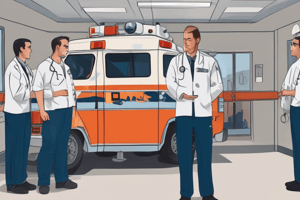Podcast
Questions and Answers
What is the rate of CPR in breaths and compressions?
What is the rate of CPR in breaths and compressions?
6 breaths and 110 compressions in a minute
What is considered tachycardic for an adult?
What is considered tachycardic for an adult?
Heart rate more than 100
What is considered bradycardic for an adult?
What is considered bradycardic for an adult?
Heart rate less than 60
When is nitroglycerin not advised to be administered?
When is nitroglycerin not advised to be administered?
Signup and view all the answers
Where does blood flow after it leaves the left ventricle?
Where does blood flow after it leaves the left ventricle?
Signup and view all the answers
What medication is contraindicated with erectile dysfunction medications?
What medication is contraindicated with erectile dysfunction medications?
Signup and view all the answers
What is the parasympathetic system responsible for?
What is the parasympathetic system responsible for?
Signup and view all the answers
What is the function of the carotid artery?
What is the function of the carotid artery?
Signup and view all the answers
Are open-ended or closed-ended questions better to ask?
Are open-ended or closed-ended questions better to ask?
Signup and view all the answers
What delivers blood to the right atrium?
What delivers blood to the right atrium?
Signup and view all the answers
What does diastolic blood pressure refer to?
What does diastolic blood pressure refer to?
Signup and view all the answers
What is TIA?
What is TIA?
Signup and view all the answers
When do you change roles during CPR?
When do you change roles during CPR?
Signup and view all the answers
What is another name for a heart attack?
What is another name for a heart attack?
Signup and view all the answers
What does nitroglycerin do?
What does nitroglycerin do?
Signup and view all the answers
When cells are deprived of oxygen and die, they are called?
When cells are deprived of oxygen and die, they are called?
Signup and view all the answers
What type of heart attack is extremely common in the elderly?
What type of heart attack is extremely common in the elderly?
Signup and view all the answers
What is arteriosclerosis?
What is arteriosclerosis?
Signup and view all the answers
What is pericardial tamponade?
What is pericardial tamponade?
Signup and view all the answers
What happens when someone has pericardial tamponade?
What happens when someone has pericardial tamponade?
Signup and view all the answers
If a patient is unresponsive with a pulse, you:
If a patient is unresponsive with a pulse, you:
Signup and view all the answers
What does a sphygmomanometer measure?
What does a sphygmomanometer measure?
Signup and view all the answers
What is a normal systolic blood pressure for a child?
What is a normal systolic blood pressure for a child?
Signup and view all the answers
What are three things to check if suspicious of a stroke?
What are three things to check if suspicious of a stroke?
Signup and view all the answers
What are the actions of nitroglycerin?
What are the actions of nitroglycerin?
Signup and view all the answers
What happens if a patient has preeclampsia?
What happens if a patient has preeclampsia?
Signup and view all the answers
What is an ischemic stroke?
What is an ischemic stroke?
Signup and view all the answers
What is the normal heart rate for a child?
What is the normal heart rate for a child?
Signup and view all the answers
What ratio should two-person CPR on a child be done at?
What ratio should two-person CPR on a child be done at?
Signup and view all the answers
What is the correct treatment for someone undergoing asphyxial cardiac arrest?
What is the correct treatment for someone undergoing asphyxial cardiac arrest?
Signup and view all the answers
What is the most common reason for cardiac arrest in children?
What is the most common reason for cardiac arrest in children?
Signup and view all the answers
What does the term lumen refer to in EMS?
What does the term lumen refer to in EMS?
Signup and view all the answers
What are the rescue breathing guidelines?
What are the rescue breathing guidelines?
Signup and view all the answers
What does placing a folded towel underneath a child's shoulders do?
What does placing a folded towel underneath a child's shoulders do?
Signup and view all the answers
What does DKA cause?
What does DKA cause?
Signup and view all the answers
What do alpha 1 receptors do?
What do alpha 1 receptors do?
Signup and view all the answers
What do beta 1 receptors do?
What do beta 1 receptors do?
Signup and view all the answers
Study Notes
CPR and Respiratory Guidelines
- CPR rate is 6 breaths and 110 compressions per minute.
- Change roles in CPR every two minutes to prevent fatigue.
- Adult rescue breathing is 1 breath every 5-6 seconds; for children, it's 1 breath every 3-5 seconds.
- Two-person CPR ratio for children is 15:2.
- For unresponsive patients with a pulse, deliver 2 quick rescue breaths followed by breaths at a rate of 10-12 per minute.
Cardiac Conditions and Measurements
- Tachycardia in adults is defined as a heart rate greater than 100 beats per minute.
- Bradycardia in adults is a heart rate below 60 beats per minute.
- Systolic blood pressure under 100 indicates nitroglycerin should not be given.
- Normal systolic blood pressure for a child ranges from 80-110.
- Normal heart rate for a child is between 70-110 beats per minute.
- A sphygmomanometer is used to measure blood pressure.
Medical Emergencies and Treatment
- An acute myocardial infarction is another term for a heart attack.
- Silent heart attacks are particularly common in the elderly.
- Ischemic strokes occur when blood flow is obstructed to a part of the brain.
- TIA, or transient ischemic attack, refers to blocked blood vessels in the brain temporarily.
- Preeclampsia presents with hypertension and can lead to seizures.
Vascular and Cardiac Anatomy
- After leaving the left ventricle, blood flows to the aortic arch.
- The carotid artery carries blood from the heart to the head.
- The superior and inferior vena cava deliver blood to the right atrium.
- The term lumen describes the diameter of a blood vessel or tube.
Pharmacology and Pathophysiology
- Nitroglycerin dilates blood vessels, reduces heart preload, and is contraindicated in patients taking erectile dysfunction medications.
- Diastolic blood pressure indicates vascular pressure during heart relaxation (bottom number).
- Arteriosclerosis involves the thickening of arterial walls.
- Pericardial tamponade is characterized by fluid accumulation around the heart, leading to low blood pressure, muffled heart sounds, and a weak pulse.
Important Signs and Symptoms
- Check for speech, facial droop, and arm drift when assessing for a stroke.
- Infarcted cells result from oxygen deprivation.
- DKA (Diabetic Ketoacidosis) causes frequent urination due to acid buildup in the body.
- Alpha-1 receptors are responsible for vasoconstriction, while beta-1 receptors increase heart rate and contractility.
Special Considerations in Pediatric Care
- Placing a folded towel under a child's shoulders helps align their airway.
- The most common cause of cardiac arrest in children is respiratory arrest.
Studying That Suits You
Use AI to generate personalized quizzes and flashcards to suit your learning preferences.
Description
Test your knowledge with these EMT practice test flashcards. This quiz covers essential concepts such as CPR rates, tachycardia, bradycardia, and the use of nitroglycerin. Perfect for anyone preparing for EMT certification.




